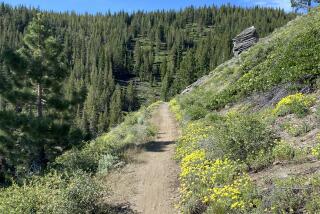Goal oriented
LIKE tourists just off the bus, we stare intently at our maps, hunting for a direction. We’re not the only ones. Around us, in a brushy meadow in Topanga State Park lit golden by the early morning sun, assorted map readers are fanning out across the field, scrutinizing cartographic details as if the markings held a route to buried doubloons. Everyone’s doing their coordinate-checking on the move, some running, some fast-hiking, since this isn’t a Gray Line Tour. It’s a race.
Unlike most racecourses, no one knows where they’re going on this one unless they check a map about every three seconds. And that doesn’t always help, I’m finding, on my first bout of orienteering, an obscure sport that started in Scandinavia about a century ago. It combines hiking, trail running, Easter egg hunting and the ability to decode squiggly lines on a topo map while dodging branches and potholes.
“I think it’s going to be over here,” I tell Clare Durand, a high-energy Valley Village orienteer who’s a leader of the Los Angeles Orienteering Club and vice president of competition for the U.S. Orienteering Federation.
She’s agreed to assist my bumbling today at a race that’s brought out a mix of athletes, wilderness aficionados, families, soldiers on training runs, and Girl and Boy Scouts who have no qualms about leaving me in the dust.
We’re in search of a white and orange nylon bag, called a control marker, one of nine control stations along the route, planted by race organizers the day before. When we find it, we’ll each stick a plastic tab attached to an index finger into a contraption that will digitally record our arrival time.
The objective: to navigate by map, compass and your wits to all the controls on the course and make it back to the starting line ASAP — or at least without the services of a search party.
“Where’d the trail go?” I ask. “Through those trees?”
“It doesn’t tell you whether it’s inside the trees or on the edge,” says Durand, looking up from her map. She’s going to let me figure it out.
I head for a clump of oak trees, the light-green area on the map — denoting “forest, slow, difficult” — and we’re suddenly plunging into a gully and back up the other side. There’s no control bag in here, but there is something else. “This stuff is poison oak,” notes Durand matter-of-factly. “Depending on how allergic you are, that may or may not be a problem.” I never knew there was an option.
Orienteers know their poison oak, not to mention earth banks, knolls and boulder groups, features that are meticulously marked on race maps by master cartographers that can cost as much as $6,000. It’s a familiarity with topography and place all but vanished from most urban faculties these days.
From GPS to MapQuest and the most common way-finding device today, the cellphone, technology has made the world safe for the directionally challenged but at the cost of dwindling geographical awareness.
“I think it’s troublesome that people don’t pull out maps as much anymore,” says Stephen C. Hirtle, a professor of information sciences at the University of Pittsburgh. “They’re losing two senses. One, they’re losing a sense of what’s around them and the notion of connectedness. And they’re also losing some problem-solving skills they used in trying to plan routes.”
And don’t forget losing that car in the mall parking structure. The good news is that observational tools can be resuscitated with practice, something orienteering addresses with the old-school technology inside your skull.
As Gary Dolgin, race director of the Topanga meet, put it before the start, “If you run like a gazelle but think like a cinder block, you are doomed. It is a thinking sport.”
There are signs that some Americans are hankering for more directions in life. “The Great Race” is drawing big TV audiences; adventure racing is booming; and orienteering, a backwater event since meets began in the U.S. in the ‘60s, is beginning to attract some new participants. There are enough adventure racers entering orienteering meets that special courses are now offered for them.
Still, the sport is tiny in the U.S., compared with Europe. One orienteering meet in Sweden attracts 5,000 people; the average participation at Southern California races is 60 to 110. There are about a million orienteers in the U.S.
*
Fast tips, then go
TO boost the ranks, orienteering experts give novices a quick tutorial on the sport before each of the races, sponsored locally by the Los Angeles and San Diego orienteering clubs.Dolgin did the run-through at Topanga’s Trippett Ranch in a grove of oaks. “We’re going to force you to find needles in a haystack,” he told a group of newbies, his rap peppered with jokes and one-liners. “If you want to run and not think, do a marathon.” He demonstrated how to read contour lines, use a compass and identify control markers.
No one gets to see a map until the starting line, which is actually a bunch of starting lines. You can choose from seven courses, color-coded for difficulty, length and verticality, from white (a mile or less) to yellow for beginners, to orange (off-trail racing begins) and, at the top end, blue (up to seven miles). I’ve opted for the yellow route, heading off on a staggered start. With each racer sent off a minute behind the last one and multiple courses, you’re really competing against yourself and the terrain.
“Which direction do you think we should go next?” challenges Durand as we come to a sloped concrete culvert, marked as two facing cliffs on the map.
“How about going across it?” After bagging a couple of controls, I’m feeling cocky. I want to cut the tangent straight to the trail. Durand, who’s actually a cartographer by trade, points out a bridge less than 20 feet away.
“A straight route is rarely the best route,” she says over the crunch of brush. Durand’s vibrant garb — blue and lemon-yellow top and pants, with beat-up gaiters on her shins for off-trail, blue-course scrambling — matches her feisty personality. “It’s figuring out from the map what’s going to be the best way to get somewhere.”
As a veteran traveler, I’m getting the map orientation thing, holding it upside down or sideways to reflect my true location, but I’m still thinking in straight lines. As a verbal type, I fall into the 50% of the population who navigate by routes, says Hirtle. We’re more comfortable with lefts and rights. The other half, the math- and science-inclined — who make up the bulk of the orienteering ranks — think about the world in spatial terms, the connections between parts.
*
Lost and found
IT isn’t long before I’m spatially stumped by a control that’s supposed to be near a fence. But so is Durand. I clamber down a slope. Nothing. Durand is not used to having a yellow marker elude her. She thinks the map is wrong. The control turns up in an oak cluster 20 feet away, causing the kind of delay that would cost a top orienteer precious minutes.As we make for a tree line across a sloping hill, I’m hiking not in the usual trance but wired by the prospect of my next find. I want more control markers. Let me at ‘em.
It’s easy to see why this wilderness scavenger hunt hooks people like Durand, who runs about 15 to 20 races a year and leads Girl Scouts on orienteering rambles, and why parents love the sport. It’s one game that can pry kids away from Nintendos into the original play station.
I bag my last control and run across the finish line, where kids of all ages are feeling quite pleased with themselves. “The navigation was much harder than I thought,” says Brian Von Debenroth, a backpacker and production company owner who’s completed his first orienteering race, “but it was great. Your heart rate gets going, but it’s very cerebral too.”
And there’s something to be said for knowing where you are in a time when many urbanites have lost their way. “If you keep going out, you will come to a point where you’re lost,” says Durand. “You’ll have to figure out how to get yourself found again. You don’t have to be afraid of being lost anymore, because you know how to survive that situation.”
*
(BEGIN TEXT OF INFOBOX)
Getting a taste of the sport
Coming up are a couple of events that can start you on orienteering.
“Running while playing chess” is how the International Orienteering Federation describes the land navigation contest that traces its roots to 1919 Scandinavian military training. The sport didn’t make it to the United States until 1946.
Today, groups sponsor special events such as ski, mountain bike, canoe and trail orienteering. Here are two upcoming local events from the Los Angeles Orienteering Club:
Dec. 11, 9:30 a.m., Vasquez Rocks, north of Sylmar.
Jan. 14-16, three-day orienteering weekend in Anza-Borrego Desert State Park.
To contact the L.A. club, call (818) 769-0906 or go to https://www.geocities.com/Yosemite/Trails/6320/ .
*
Joe Robinson can be reached at joe.robinson@latimes.com.
More to Read
Sign up for The Wild
We’ll help you find the best places to hike, bike and run, as well as the perfect silent spots for meditation and yoga.
You may occasionally receive promotional content from the Los Angeles Times.






